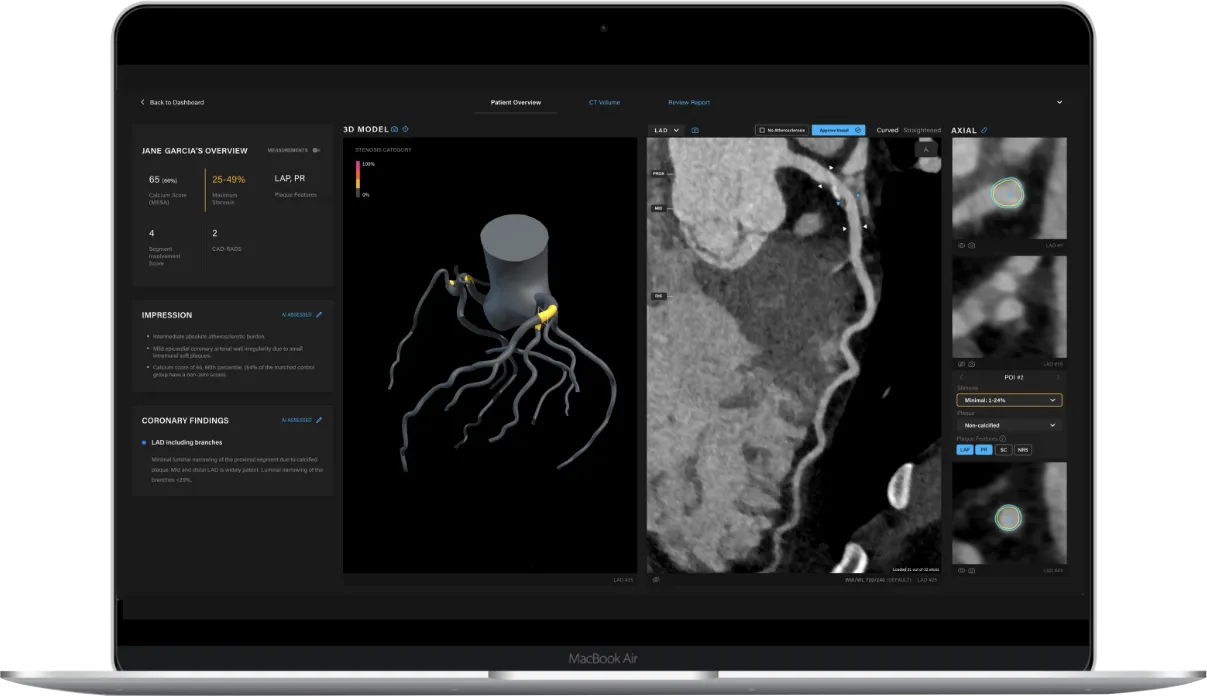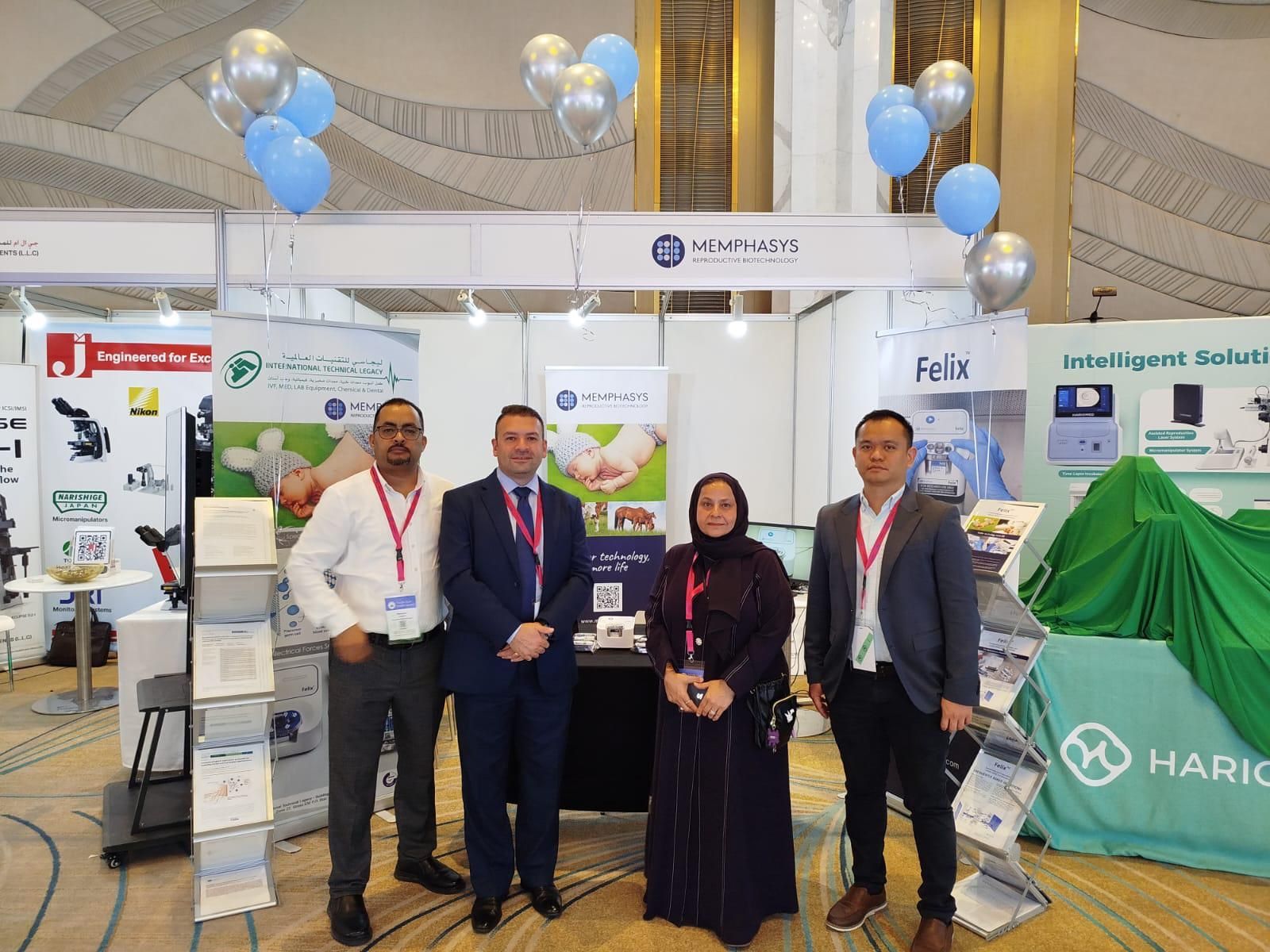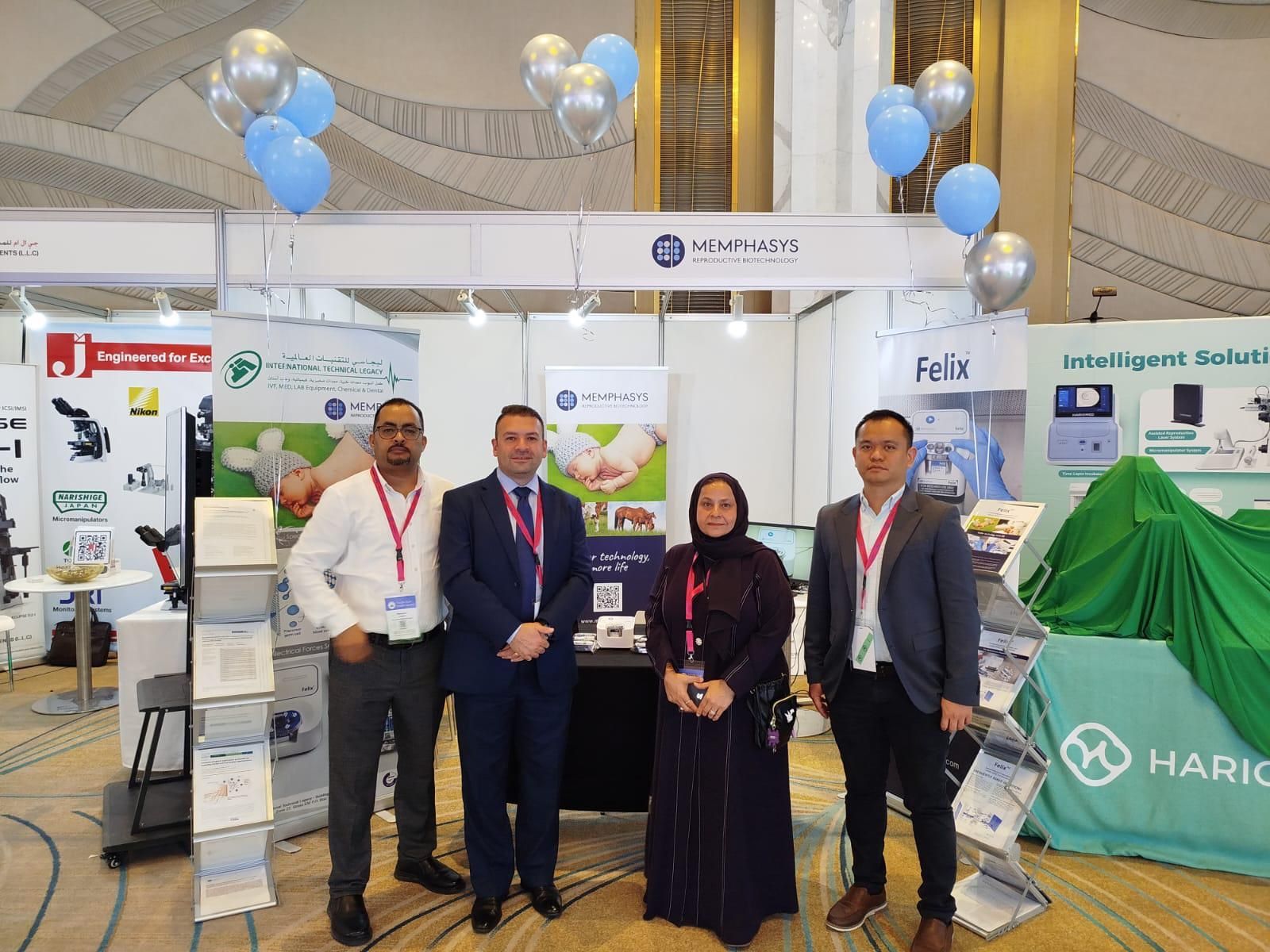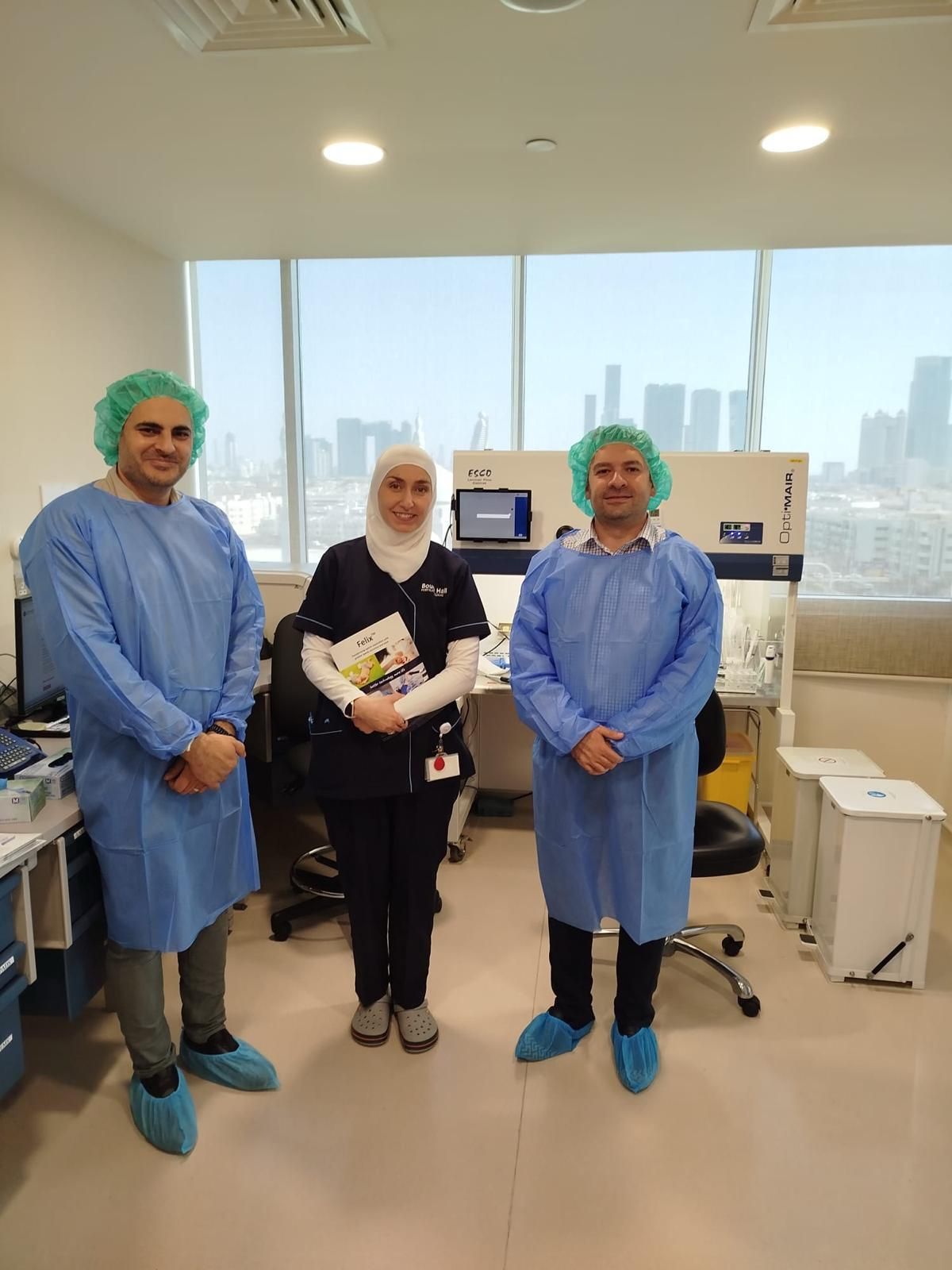
Australia’s most read investor-focused magazine for ASX-listed Tech & Biotech stocks
Trending Stories

23 December, 2025
Memphasys makes its opening European move as Felix™ gains commercial validation
For Memphasys (ASX: MEM), Europe has long been a stated priority. Today, that ambition translated into execution, with the company securing its first European commercial supply agreement - a five-year deal that provides an immediate entry point into the Italian IVF market, underpinned by committed purchase volumes and a clear pathway to scale.
The agreement, struck with Centro Fertilita Assistita (CFA Italia), marks Memphasys’ first commercial foothold in mainland Europe. Under the terms, CFA has committed to minimum purchases of 7,500 Felix™ cartridges over five years, equating to a contract value of at least €525,000, or approximately A$925,000.

CFA Italia team members meeting with clients
The purchase schedule is deliberately front-loaded, with 3,000 cartridges to be acquired across the first two years, followed by 1,500 cartridges annually thereafter. For a consumables-based medical technology model, that structure provides early revenue visibility and establishes a recurring demand profile beyond initial device deployment.
But while the contracted volumes matter, the stronger signal lies in what followed.
Ahead of any contractual obligation - and prior to CE Mark approval - CFA has already placed an initial order for 500 Felix™ cartridges, valued at A$62,500. Revenue will be recognised in the current quarter, with cash receipt expected in the next. In a sector where procurement decisions are often cautious and incremental, an early commercial order speaks louder than expressions of interest.
That order followed direct, in-market engagement, training and clinical onboarding - precisely the hands-on commercial strategy Memphasys has been executing across its priority regions. The approach is designed to shorten adoption cycles and move clinics from evaluation to utilisation, rather than waiting for regulatory milestones to do the heavy lifting.
Felix™ is positioned as a replacement for traditional centrifugation techniques used in sperm preparation, which can expose cells to mechanical stress and DNA damage. Using electrophoresis and size-exclusion membranes, the system delivers a faster, gentler and more standardised sperm selection process - attributes that resonate in high-throughput IVF laboratories.
Italy provides a meaningful proving ground. It is one of Europe’s largest assisted reproductive technology markets, with close to 97,000 ART procedures performed in 2022. IVF accounts for the majority of that activity, reflecting both sustained patient demand and significant clinical throughput.
CFA operates across a network of clinics performing thousands of IVF cycles annually and maintains established commercial relationships beyond its own facilities. As part of the agreement, CFA will actively engage this broader network to promote and sell Felix™, creating the potential for volumes to exceed minimum contracted levels over time.
That scalability is central to Memphasys’ European strategy. While the agreement locks in baseline demand, it is intended as a launch platform rather than a ceiling.
CE Mark approval is anticipated in early 2026, at which point Felix™ can be deployed across Europe without restriction. By securing a committed partner and early commercial orders ahead of regulatory activation, Memphasys positions itself to accelerate adoption rather than build momentum from scratch post-approval.
The Italian agreement adds to existing commercial arrangements in Japan, India and the Middle East, reinforcing a strategy focused on contracted, repeatable revenue in clinically significant markets.
For investors, the takeaway is less about the headline number and more about the pattern emerging beneath it: early orders, minimum commitments and partners with both clinical credibility and distribution reach.
In medical technology, progress is rarely announced in advance. More often, it shows up quietly - one purchase order at a time.
READ ARTICLE

23 December, 2025
Neurizon’s Fresh Capital Injection Paves the Way for Phase 3 ALS Trial
In a neatly wrapped pre-Christmas present for shareholders, Neurizon Therapeutics (ASX:NUZ) has secured a funding trifecta to bankroll its participation in the prestigious HEALEY ALS Platform Trial, giving its lead asset NUZ-001 a genuine crack at commercial stardom in the neurodegenerative disease space.

Announced on 23 December, the company will raise approximately $7.1 million through a placement, launch a $17.1 million entitlement offer, and draw from a $20 million convertible note facility to underwrite its upcoming clinical ambitions.
This funding overhaul will fully support the Phase 2/3 HEALEY trial, described as a pivotal registration study for NUZ-001 in amyotrophic lateral sclerosis (ALS) - a rare, fatal and currently incurable disease most Australians know better as motor neurone disease (MND).
Cash, Clout and Clinical Credibility
The raise will see roughly 89.1 million shares issued at 8 cents a pop - representing a chunky 27.3% discount to the last traded price of 11 cents. Notably, Neurizon’s directors and senior management are chipping in around $800,000, subject to shareholder approval, adding a layer of internal conviction that rarely goes unnoticed.
Backing this, a 2-for-5 non-renounceable entitlement offer gives retail investors a shot at the same entry price. Meanwhile, a $20 million convertible note facility with New York-based Obsidian Global provides a longer-term financial safety net without immediately watering down the cap table - only $5 million will be drawn initially, with flexibility built in to fund future milestones.
“This funding package fundamentally transforms Neurizon’s position,” said CEO Dr Michael Thurn, describing NUZ-001 as a “Phase 3-ready asset of international significance”. Thurn also highlighted the trial’s efficient structure and the capital's role in backing both the randomised and open-label extension phases.
A Promising Path for NUZ-001
NUZ-001 is no overnight biotech flyer. Originally a veterinary anti-parasitic called monepantel, it has undergone something of a scientific renaissance as a potential therapy for proteinopathy-driven diseases like ALS, Alzheimer’s, and frontotemporal dementia.
Neurizon’s participation in the HEALEY ALS Platform Trial - administered by the US-based NEALS network - is a coup. It means NUZ-001 will be tested in a gold-standard environment: multicentre, double-blind, placebo-controlled, with shared infrastructure that shaves time and cost. The trial aims to dose its first patient in Q1 2026, with 160 patients enrolled across 70 US sites.
In prior Phase 1 and open-label extension studies, NUZ-001 delivered encouraging signs: a 76.7% reduction in mortality risk and a doubling of life expectancy when compared to historical controls. Not bad for a molecule once used to deworm sheep.
Balance Sheet Fortified, Vision Enlarged
Beyond ALS, Neurizon is eyeing broader neurodegenerative indications - Huntington’s disease and frontotemporal dementia are already in the preclinical pipeline. Some of the fresh funds will support early-stage work in these areas, aligning with NUZ-001’s mechanism as a modulator of protein homeostasis.
The convertible note structure - with its milestone-based drawdowns and anti-dilution considerations - also gives Neurizon optionality. It’s designed to avoid the dreaded death spiral that haunts many small-cap biotech financings. Importantly, the company can pursue grants or regional partnerships without being locked into fully using the facility.
Market Reaction and Outlook
While the discount in the placement raised some eyebrows, the broader investor response appears supportive. The deal also strengthens Neurizon’s hand in future negotiations with regulators, partners, or acquirers - especially if NUZ-001 continues to hit its clinical marks.
Assuming the first patient is dosed as planned in early 2026, topline data from the HEALEY trial could be ready by Q3 2027. If the stars align, this could position NUZ-001 for accelerated regulatory approval via the FDA’s fast-track process - particularly given its safety profile and mechanism of action.
In biotech, promises are easy, execution is everything. For now, Neurizon has lined up the capital, collaborators and clinical runway to deliver on what it calls “a differentiated, late-stage clinical ALS asset.”
Time, and data, will tell.
READ ARTICLE

23 December, 2025
Artrya Adds Cone Health to U.S. Roster, Notching Third Major Win for Salix® Platform
In a timely pre-Christmas announcement, ASX-listed medtech player Artrya (ASX: AYA) has unveiled its third U.S. commercial customer, signing a five-year software agreement with North Carolina-based Cone Health. The deal rounds out a trio of American “foundation partners” who have now transitioned from pilot collaborators to paying clients, marking a key milestone in Artrya’s U.S. expansion.
The agreement, worth a minimum of US$450,000 over its term, grants Cone Health access to Artrya’s Salix® Coronary Anatomy software, which uses AI to assess coronary artery disease in near real-time. A separate revenue stream will also kick in from use of the Salix® Coronary Plaque module, which attracts fee-per-scan charges and benefits from U.S. reimbursement eligibility under a Category 1 CPT code.

Cone Health - a not-for-profit health system comprising five hospitals and over 120 physician practices - first partnered with Artrya in mid-2024 in a test integration phase. That groundwork involved technical assessments of how Salix® interacts with Cone’s picture archiving and communication systems (PACS) and electronic medical records (EMR). With those boxes ticked, Salix® will now be rolled out across Cone’s entire network, integrated into routine clinical workflows.
The Salix® software is pitched as a solution to streamline and accelerate the diagnosis of coronary artery disease. According to Dr Wesley O’Neal, Medical Director of Cardiac CT and Nuclear Cardiology at Cone Health, the system provides “accurate, point-of-care interpretation of CCTA scans within minutes,” enabling “faster, more precise diagnoses”.
Echoing this endorsement, Cone’s Executive Director of Heart and Vascular Services, Sheryl Booth, noted that Salix® will reduce diagnostic variability and improve care delivery across the network. She also praised Artrya’s onboarding support team, which is based in Atlanta and was established to ensure U.S. clients are handheld through the implementation process.
From Artrya’s perspective, converting all three U.S. foundation partners to commercial clients in a single calendar year is more than just a sales victory. It validates the company’s collaborative model of embedding its tech into hospital systems via joint development, rather than cold-selling off the shelf.
“We have now successfully converted all three of our foundation partners to commercial customers, which highlights the benefits of our partner collaborations to validate the clinical and commercial use of Salix®,” said CEO and co-founder John Konstantopoulos. “This also shows our growing commercial momentum as we move into 2026”.
On paper, the recurring revenue structure provides a degree of predictability: fixed monthly fees for the Coronary Anatomy platform, and usage-based revenue for the plaque detection module. Importantly, the latter is already eligible for reimbursement in the U.S., which removes a common hurdle for medtech commercialisation in that market.
While the full financial details remain commercial-in-confidence, Artrya disclosed that the agreement includes standard SaaS terms, including 30-day termination clauses with no cancellation penalties, as well as data security and upgrade provisions.
Artrya is now eyeing 2026 as the year to scale within its existing U.S. customer base, with its Atlanta-based Customer Success team playing a central role in that strategy. After all, in health tech, success isn’t just about selling the software - it’s about embedding it into workflows, achieving clinical buy-in, and generating those crucial recurring revenue streams.
With three U.S. clients onboard, Artrya has shown it can play in the competitive North American market. The challenge now is turning early traction into sustained growth. Investors will be watching closely to see if the company can continue this momentum and perhaps convert more test sites into paying customers in the new year.
READ ARTICLE

18 December, 2025
Memphasys: From Lab Bench to Commercial Breakthrough – 2026 Shapes Up as a Watershed Year
It’s not often that a small-cap ASX biotech genuinely turns the corner from development to commercial traction, but Memphasys (ASX: MEM) may have just done exactly that - and without waiting for the regulatory starting gun.
Today’s ASX announcement from the reproductive biotech outfit revealed a crucial early order of 500 Felix™ cartridges from Middle Eastern partner International Technical Legacy (ITL), made before CE Mark approval has even landed. That’s roughly A$40,000–$75,000 in expected revenue being booked ahead of the formal regulatory nod – the commercial equivalent of banking runs before the first whistle.

This premature but enthusiastic order is no contractual formality. Under the five-year distribution deal signed with ITL, the minimum cartridge order was only due once the Felix™ system received its CE Mark, expected in early 2026. Instead, strong demand from IVF clinics in Qatar and the UAE has led to this early activation, a development Memphasys attributes directly to its direct-selling commercial model.
This is not just a tweak to go-to-market strategy - it’s the culmination of a strategic pivot that saw the company shed its CEO earlier this month, replacing top-down executive structure with a boots-on-the-ground business development offensive. With operational veteran Dr Hassan Bakos now spearheading the effort as Director - Clinical Engagement and Growth, the company is betting on intimacy with IVF clinics rather than distance via distributors.

Bakos’ recent whirlwind tour of roughly 15 IVF clinics in the Gulf states appears to have paid off. Each clinic represents a recurring cartridge revenue opportunity of A$100,000 to A$300,000 per annum once the Felix system is fully adopted. His hands-on demonstrations and workflow integration efforts have made sites “switch-ready,” meaning they can flick to active usage of Felix the moment the CE Mark comes through.
Chair of the Commercialisation Committee, Marjan Mikel, put it plainly: “This outcome reflects disciplined commercial execution... ITL’s decision to place a 500-cartridge order ahead of the contractual trigger demonstrates genuine confidence in Felix™”.
The direct-selling strategy is particularly tailored for regions like the Middle East, where large-scale IVF operators prefer vendor relationships built on education and clinical collaboration, not just sales brochures. It's this bottom-up clinical demand - as opposed to top-down distributor push - that has brought Memphasys closer to recurring revenues with real visibility.

More broadly, 2026 is shaping as the year Memphasys moves beyond hopeful projections and into revenue realisation. The long-awaited CE Mark will unlock not just the EU, but several other CE-recognising markets including India and Australia. In anticipation, the company has already begun scaling its operations, shifting commercial resources offshore and lining up supply-chain logistics to support immediate deployment.
What’s unfolding is a textbook commercial pivot: restructure the C-suite, redeploy capital to sales roles in key markets, and build clinic-level momentum before the gates officially open. Memphasys is using its Felix™ system - a patented sperm-selection device for assisted reproduction - as its wedge into a global IVF market that is both clinically conservative and commercially competitive.
And while this isn't yet a blockbuster order - 500 cartridges alone won’t pay for the whole lab coat – it is a market signal. Clinics are ready. Partners are engaged. Systems are in place. The patient, so to speak, is prepped.
By front-loading demand and sidestepping regulatory delays, Memphasys appears to have done what few pre-commercial biotechs manage: convert potential into preparedness. With CE Mark approval now tantalisingly close, 2026 might not just be a pivotal year for Felix™, but for Memphasys itself.
As the lab-coat phase gives way to the lab-revenue phase, investors will now be watching how many of those forecasted clinic orders - each worth a small fortune in cartridges - translate into invoices and cash flow. The science is proven. The demand is knocking. All that remains is regulatory clearance and, in all likelihood, the beginning of a new chapter for this Aussie biotech minnow.
READ ARTICLE

17 November, 2025
Adisyn Advances Graphene Deposition Program with Key Milestone
Adisyn Ltd (ASX: AI1) has announced a notable technical achievement in its pursuit of scalable graphene-based solutions for the semiconductor sector. Through its wholly owned subsidiary, 2D Generation (2DG), the company has successfully validated a critical sub-process within the pre-clean stage of its proprietary low-temperature graphene deposition process - a necessary step before graphene growth on semiconductor wafers can occur.
This milestone confirms that Adisyn’s deposition architecture is performing in line with design expectations and will now progress to broader deposition trials.
According to Chairman Kevin Crofton, “Validating this key sub-process within our pre-clean stage is a meaningful technical advancement and a strong indicator that our low-temperature approach will work as designed.”
The company’s objective is to enable direct graphene growth on semiconductor wafers - a long-standing challenge in the industry - without resorting to the ultra-high temperatures (900–1000°C) typically required in conventional graphene growth methods.
Context: The Interconnect Bottleneck
Modern semiconductor performance at advanced nodes, particularly below 5nm, is increasingly constrained by the physical limitations of copper interconnects. These components are responsible for carrying electrical signals between transistors on a chip, but as features shrink, copper's resistance, thermal inefficiency, and susceptibility to electromigration present critical obstacles to further miniaturisation and energy efficiency.
Graphene, a two-dimensional form of carbon with exceptional electrical, thermal, and mechanical properties, has long been considered a potential replacement. However, its adoption has been hindered by integration challenges, particularly the need for high-temperature chemical vapour deposition methods incompatible with standard semiconductor processes.
Adisyn’s approach - based on a patented Atomic Layer Deposition (ALD) technique - seeks to overcome this barrier by enabling low-temperature, scalable graphene growth. This process is designed to integrate seamlessly with existing semiconductor fabrication infrastructure.
Technical Progress and Next Steps
The recently validated sub-process involves a surface pre-clean protocol that ensures wafers are free from residual contaminants and chemically prepared for graphene deposition. The company will now commence extensive deposition trials using various carbon-ring-based precursors. Concurrently, it will refine remaining sub-processes, optimise deposition parameters (such as plasma power and gas flow), and characterise resulting films for crystalline quality and conductivity.
Adisyn ALD Machine
This experimental program is expected to run into 2026, aligned with the company’s previously disclosed development roadmap.
Strategic Collaborations and Global Capability
Adisyn is leveraging a broad network of international collaborators to accelerate development. These include Tel Aviv University’s Nano Centre - providing access to a second ALD machine - and imec, Belgium’s pre-eminent semiconductor R&D hub, which is conducting simulations and physical validation testing. The company is also engaged with the European Union’s Connecting Chips Initiative, a platform that links Adisyn with industry leaders such as NVIDIA, NXP, Valeo, and Applied Materials.
Adisyn’s R&D efforts are supported by a multi-disciplinary team of over 20 professionals across Israel, the United States, and Europe, with deep expertise in deposition chemistry, nanomaterials, process engineering, and device integration.

Arye Kohavi and Kevin Crofton
The leadership team includes Chairman Kevin Crofton, former CEO of Comet AG and SPTS Technologies; Arye Kohavi, CEO of 2D Generation and founder of Water-Gen; and Miri Kish Dagan, VP of R&D, a veteran technologist in semiconductor and laser systems.
Market Position and Outlook
As at mid-October 2025, Adisyn’s market capitalisation stood at approximately $46 million, with $7 million in cash reported as of 30 June 2025. While the company remains in a pre-revenue development phase, the potential commercial applications of its technology span several high-growth sectors including AI, telecommunications, high-performance computing, and autonomous systems.
The successful development of a scalable, low-temperature graphene deposition process would represent a substantial breakthrough in semiconductor manufacturing and could position Adisyn as a first mover in an emerging materials segment. The company expects to provide further updates as it progresses through subsequent development phases, including wafer-level deposition and precursor performance optimisation.
While commercialisation remains a medium-term goal, the validation of this early-stage process architecture provides a solid foundation for continued advancement and industry engagement.
READ ARTICLE
Latest News
ALL NEWS
Latest Web & Podcasts
ALL WEB & PODCASTS

Book Now for the Next Edition
Reach real investors through TechInvest Magazine, distributed as an independent insert in The Australian Financial Review, online via www.techinvest.online as well as across investor-focused social media channels.
Book now for TechInvest Edition 4, coming in 2024 with many opportunities to showcase your Tech insights.
What you get:
- Article on your company written by a highly experienced writer or supplied by your company
- Approved article included in TechInvest and replicated on www.techinvest.online
- Two page ‘Company in Focus’ features receive prominent pointer on front page of magazine
- Copy of article (copyright free) for you to use for own marketing purposes
- 10 copies of magazine

Upcoming Webinars
ALL WEBINARS











